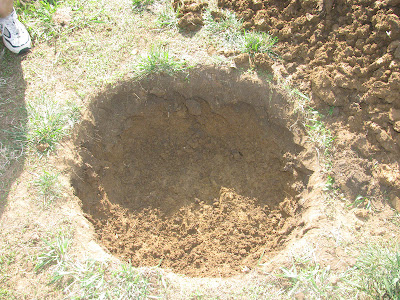The additions to our orchard for Spring 2012 are three semi-dwarf apple trees and three highbush blueberry bushes. I'll cover the blueberries in a later post. :)
The first thing you need to do before you plant apple trees is find a good place for them on your property. Ours are located on the southwest corner of our 5 acres, the area we have set aside for the bulk of our fruit trees.
 |
| We marked the locations for the trees, taking their mature size into account and siting them well away from the pecans |
The apple trees are just east of where we planted the pecan trees last fall. Since a mature pecan tree can have a canopy in the neighborhood of 80 feet in diameter, we made sure to select locations that would not be shaded in the future. Of course it will be a looooong time before our pecan trees are large enough to be a threat to the apples, but we're planning for the future!
Our apple trees are semi-dwarf, which means they can grow to be about 15 feet across. We measured out and marked an equilateral triangle with sides that measured 15'. Who said high school geometry isn't useful?
The night before we planted our trees we soaked them in buckets that contained a solution of liquid kelp in water. Our trees came bareroot and Michael Phillips, author of my much-beloved The Holistic Orchard: Tree Fruits and Berries the Biological Way,
 |
| Soaking the trees overnight in a kelp solution. Our storage room is the coolest place I could find, so that's where the trees landed until planting. |
The next morning dawned sunny and warm. Ideally, you would plant trees on an overcast, wind-less day. It's better for the plants. We didn't have much choice in the matter, however, so we trusted in the awesome power of kelp to keep our trees from freaking out and got underway.
Please learn from my mistake: if you are going to dig halfway to China on a unseasonably sunny and warm spring day, apply your sunscreen with great care. I just kind of slapped it on and by the end of the day the back of my neck, ear lobes, part of my left cheek and triceps were burnt to a crisp. I look like I have some rare kind of skin disease.
 |
| It felt like we were digging to China |
You need a hole that is about 3 feet wide and 16-20 inches deep. If you are digging through clay, you will want to give up about halfway but persevere! A large hole means you are loosening a lot of soil and your tree will pay you with abundant growth. We tried to break up the sides of the hole as much as we could because "otherwise [the roots] may circle around the glazed bowl that can inadvertently result from clay particle adhesion caused by digging the hole." (Phillips, 52)
After you have dug your hole, you will look at your small tree and wonder if it will be completely swallowed up by the giant chasm that you just made in your lawn. Nope, because the next step is to take some of the best quality dirt (i.e. topsoil, not clay) plus the amendments I will discuss and form a mound of loose soil on the bottom of the hole. Gently place your tree on top of the mound and spread the roots out.
 |
| Hubby Dear placed the tree on the mound of loose soil and spread the roots out |
Check the graft union - that's the bumpy part where the rootstock has been joined to the trunk. Make sure it is about 4 inches above the level of the ground. If you plant your tree too deep, the rootstock might send out growth of its own and the resulting tree would not be the variety that you desire. As you add dirt back into the hole and tamp down the soil, the tree will settle a bit so it is important that the graft union starts off high enough.
Now let's talk soil amendments. Michael Phillips recommends the following:
Now let's talk soil amendments. Michael Phillips recommends the following:
 |
| Organic soil amendments to add at planting: rock phosphate, mycorrhizal inoculant, azomite, and humic acids |
Each tree gets 1 lb of rock phosphate and 1 lb of azomite. We mixed this as well as some humic acids into the mound at the bottom of the hole and into the soil we filled in around the roots. The roots themselves were sprinkled with mycorrhizal inoculant.
What's mycorrhizal inoculant, you ask? Mycorrhizal fungi are present in healthy woodland and orchard soils. They partner with trees in a symbiotic relationship. It's too involved for me to write it all out here, but suffice it to say fungi are the key to healthy, happy, organically-grown fruit trees. Mycorrhizal inoculant is the best way to insure fruit trees have these fungal partners from the beginning.
After we dusted the roots with the inoculant, we continued to fill in the hole with the best dirt, reserving the worst of the clay for the top. The roots will thrive in the good stuff and the tree will grow strong quickly. The clay will get improved over time from the amendments that will be applied from above.
When we had the hole about 3/4 of the way filled in, we placed a stake on the side of the tree opposite of the prevailing winds.
Then we tamped down the soil firmly and watered well. I took some of the remaining chunks of clay and arranged them in a ring around the tree to help hold water in the root zone.
What's mycorrhizal inoculant, you ask? Mycorrhizal fungi are present in healthy woodland and orchard soils. They partner with trees in a symbiotic relationship. It's too involved for me to write it all out here, but suffice it to say fungi are the key to healthy, happy, organically-grown fruit trees. Mycorrhizal inoculant is the best way to insure fruit trees have these fungal partners from the beginning.
After we dusted the roots with the inoculant, we continued to fill in the hole with the best dirt, reserving the worst of the clay for the top. The roots will thrive in the good stuff and the tree will grow strong quickly. The clay will get improved over time from the amendments that will be applied from above.
When we had the hole about 3/4 of the way filled in, we placed a stake on the side of the tree opposite of the prevailing winds.
Then we tamped down the soil firmly and watered well. I took some of the remaining chunks of clay and arranged them in a ring around the tree to help hold water in the root zone.
 |
| Our new Jonafree, GoldRush, and Enterprise apple trees |
And that's it! Most people recommend that you do not fertilize fruit trees the first year after planting, so other than watering as necessary, they won't require too much attention this year.
Other than a whole bunch of ramial mulch. But that's a post for another day.
Other than a whole bunch of ramial mulch. But that's a post for another day.












Spot a fallen tree? Call tree removal queens to get it out of your way.
ReplyDelete